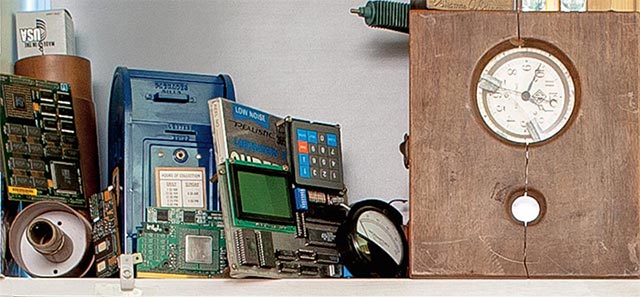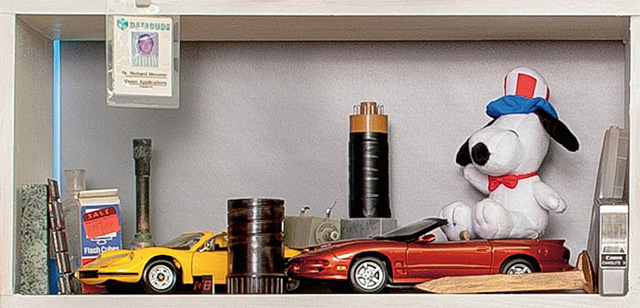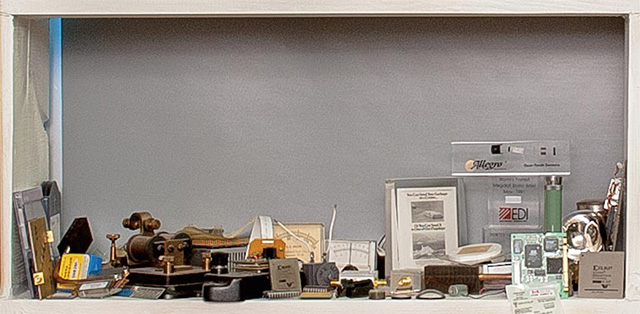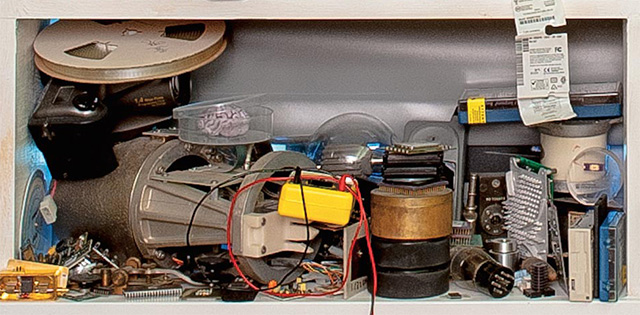|
|||||||||||||
|
|||||||||||||
An interactive glimpse of Messner's office museum:shelf outlines:


REEL-TO-REEL TAPE
Although younger readers might not know what reel-to-reel tape is, I’m sure older readers will fondly recall it. Analog reel-to-reel magnetic tape recording was used for decades to record music. One of the most successful recording media of all time it has all but been replaced by digital recording methods which store digital data in electronic memory modules.
COAXIAL CONNECTOR
This right angle coaxial connector comes from the 400-foot Channel 11 transmitter tower on Saddleback Mountain in Northwood, N.H. I take students in my communication design course to see these transmitting facilities and when I was there last, they had some left over old coax from a previous tower update. I asked for a sample for my collection and here it is.
SYNCHRO-CLOCK
This synchronous motor-driven clock c. 1930, made by General Radio in Cambridge, Mass., measured time in .1 second intervals and was used for experiments where timing was an important component of the experiment (Note wooden Vermont bulls--t grinder on top.)
SIMPLEX CABLE
This is the inner core of a Simplex ocean cable, which transmits vast amounts of digital data between countries separated by miles of ocean. This cable is made up of six fibers encased in layers of stainless steel wire, copper sheathing, Teflon, and an outer shield impervious to the elements and shark bites. The cable is spooled out along the ocean floor by giant ships, as they traverse the ocean. 
SHIP
My father was an executive at Transistron in Wakefield, Mass., during the late 1960s. In my dad’s office, there was a very cool lamp that had a ship attached with a nightlight behind the middle mast of this ship. When my dad retired, he gave me the lamp and the ship is now displayed in my office. CRYSTAL OVEN
This is a device that uses a temperature-controlled oven chamber to maintain a quartz crystal in an electronic oscillator at a constant temperature. This prevents changes in frequency due to variations in ambient temperature. They are typically used to control the frequency of radio transmitters, cellular base stations, military communications equipment, and for precision frequency measurement. PENTIUM II PROCESSOR
This is a sixth-generation microprocessor introduced by Intel in May of 1997. It contained 7.5 million transistors. In early 1999 the Pentium II was superseded by the Pentium III. VOLT METER
This AC voltage meter was used in the Electrical and Computer Engineering power lab from the early 1900s through the 1980s. They have now been replaced with digital meters; however, we still maintain some for power-related courses. 
PHOTO-MULTIPLIER TUBE
How do you measure a particle of light or count photons? You’ll need a photo multiplier tube like this vintage RCA Model 6199 c. 1950, which was used in a variety of applications, one of the most interesting being a circuit for headlight dimmers on automobiles, specifically Cadillacs and Oldsmobiles.
SNOOPY
As I was walking through the student groups at the UNH picnic day one fall, I saw this Snoopy sitting on a table, asked if I could have it for my office—and was delighted when the young woman at the table simply offered it to me.
CARS
When I was in grade school, I used to collect Hot Wheels, always hoping I could eventually buy one. Since even now I can’t actually afford to buy such a vehicle, I figured the next best thing was to collect a few of these smaller versions. This shelf features a die-cast Yellow Ferrari Dino 246GTS and red 2002 Firebird Trans Am. 
CARS
Here are some more die-cast cars: a Blue Crown Victoria stacked on top of a yellow Porcshe 911 Carrera, a green Lamborghini Murcielago, next to a red Ferrari 550 Barchetta. And…last but not least, a Waste Management trash truck I picked up during a “touch-a-truck” event I was volunteering at for the Richie MacFarland Center.
BLACK TUBE
This is a line scan camera used for image acquisition in industrial applications, such as quality inspection for industrial multi-color printing, plate glass production, and more.
BLUE CAPACITOR
This is a 1000-microfarad capacitor rated at 200 Volts Direct Current. I use this capacitor to build up a large charge over the duration of a lecture to our freshman class. At the end of class, when we have discussed how we cannot charge or discharge a capacitor in zero time, I try to do so and short the capacitor with long handled screwdriver. This results in a very loud “bang” and generates a large spark, thus demonstrating the principles learned.
COMMUNICATIONS TUNING CIRCUIT
This is a multiple stage tuning circuit for a communications receiver from the 1940s. I have opened up the metal housing to allow students to see the internal components.
SELENIUM RECTIFIER
C. E. Fitts first observed the photoelectric and rectifying properties of selenium around 1886, but practical rectifier devices were not manufactured routinely until the 1930s. They were used to replace vacuum tube rectifiers in power supplies and other high- voltage diode circuitry. 
TELEGRAPH KEY SET
Telegraph relay from the late 1800s. This was used in conjunction with a telegraph key to enable the transmission of information via Morse code.
HALL EFFECT
This lucite-encased Hall Effect components manufactured by Allegro Microsystems, Inc. and given to me by a former student who worked at Allegro.
MEMORY BARE DIE
Lucite encased digital memory bare die from Electronic Devices, Inc. (EDI) also given to me in my travels.
FIELD PROGRAMMABLE GATE ARRAY
This Xilinx Field Programmable Gate Array (FPGA) allows one to perform very complex designs in a flexible way, which vastly reduces engineering costs and time to market. 
WIND KNOT METER: to measure wind velocity
Analog meters were commonly used to depict information to a user via a moving pointer. Based on the D’arsonval meter movement this circular meter was calibrated to indicate wind velocity.
SLIDE RULE
This slide rule was given out by Clarkson University to commemorate their receiving the 2001 Boeing Outstanding Educator Award. Being a member of Clarksons advisory board I was given this slide rule which now sits prominently among other items in the collection.
IBM SELECTRIC TYPE BALLS
For years secretaries used IBM selectric typewriters. These are two of the “ball” styluses that were used in a IBM selectric II typewriter. These specific ones were used by the secretary who I had paid to type my Masters thesis at Clarkson.
PHONE
This Western Electric rotary telephone was once used in a children’s playhouse that was located in the backyard of a family friend during the 1960s. When they moved it was given to me along with other items. 
OLYMPUS DIGITAL CAMERA
Description goes here: 20-80 words. RK05 Disk Drive
Disk drive head assembly for a Digital Equipment Corporation RK05 Disk Drive stored approximately 2.5 MB on a 14 inch, single-platter IBM-2315-style front-loading removable disk cartridge. The cartridge permitted users to have relatively unlimited off-line storage and to have very fast access to such data. The drive itself plus the controller cost $7,900 dollars, and each removable disk cost $99. 
WAFER OF INTEGRATED CIRCUITS
Integrated circuits are manufactured on large wafers and then cut by diamond saws into single units that are subsequently packaged into units that are sold. This is a four-inch wafer, but wafers today can be upwards of 12 inches in diameter. MICROWAVE CIRCUIT and
SLOTTED LINE MICROWAVE WAVE GUIDE
Here is a microwave circuit that has been opened to expose the internal circuitry. Next to it is a Slotted Line Microwave Wave Guide. This is used for microwave measurements and consists of a moveable probe inserted into a slot in the transmission line. Although they are not often used today, they can produce very accurate results. TUNED CAVITY RESONATOR
This device is an electromagnetic resonator that was used in a microwave frequency generator. The waves are created by injection of microwave energy into a hollow space inside the device RADIO WAVE TRANSMITTER TUBES
These radio frequency (RF) vacuum tubes were used by ECE UNH emeritus faculty member Ronald Clark in a radar system designed to track meteors entering earth’s upper atmosphere. Dr. Clark’s research was funded for many years by the National Science Foundation. |

